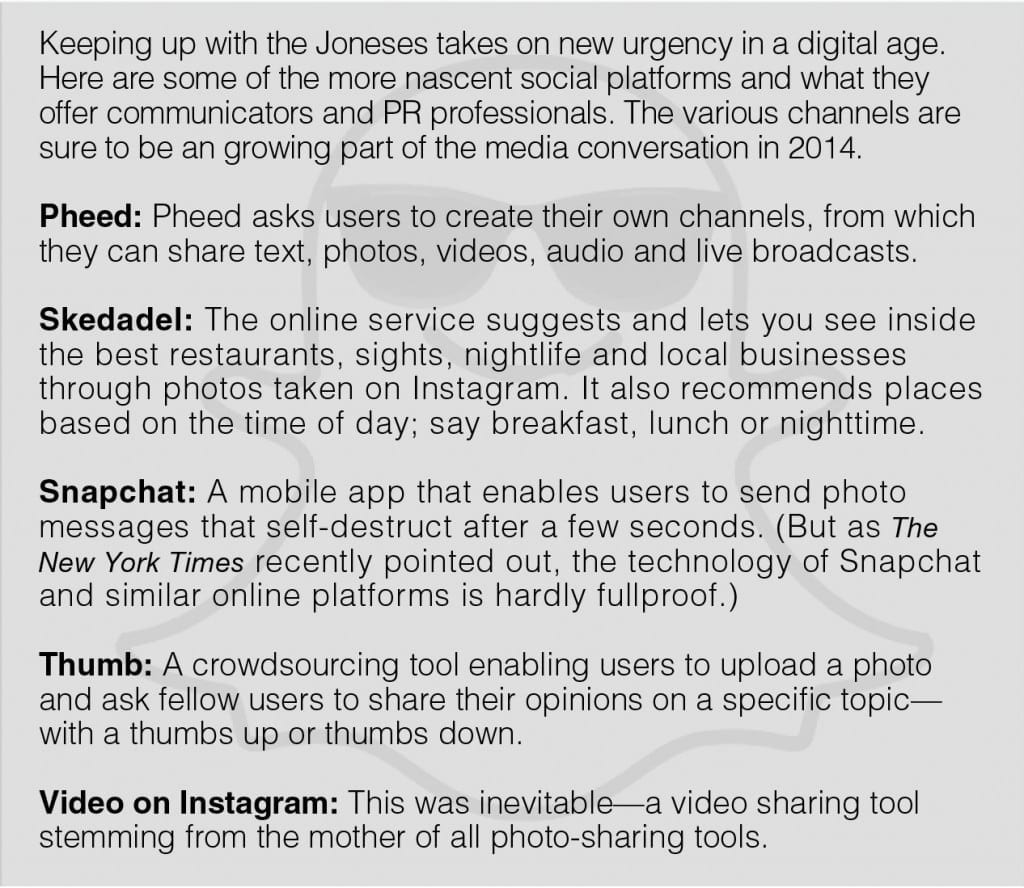Facebook, Twitter and, to a increasing degree, Instagram tend to suck up most of the oxygen when it comes to how communicators can leverage social networks and align them with corporate goals and objectives. But in the last several months a slew of new social networking tools have strutted across the social landscape prompting massive attention throughout the media. For example, earlier this month Instagram rolled out Instagram Direct, enabling users to directly message other people instead of broadcasting the message to all of their follower. And in November mobile app Snapchat rejected a $3 billion buyout from Facebook. Snapchat, which launched in 2011 and reportedly has more than 5 million users, enables consumers to send photos and videos and set a time (up to 10 seconds) for how long recipients can view their “Snaps.”
There are other social channels now flying just below the radar for PR pros to consider, such as Buffer, a software application designed to manage social networks, and Tweepi, which helps you manage your Twitter accounts.
We’re no doubt missing a few of these social platforms, what with fluidity in the marketplace. Of course, many of these new platforms revolve around video, a fairly clear indication that, however gradually, text may become subordinate to video when crafting a message.
But the bigger question for communicators is whether Snapchat, Instagram et al. have legitimate applications for business communications? Acura and Taco Bell think so, apparently. Both brands have recently used Snapchat to plug some of their new products.
SKY’S THE LIMIT?
“The possibilities are endless,” said Justin Champion, digital marketing supervisor at PR agency French West Vaughan, referring to Snapchat.
The agency is now considering how some of its clients may be able to leverage Snapchat for PR purposes, according to Champion.
“For us, it’s the data, the numbers and the type of engagement,” he said, referring to a general rule of thumb for assessing new social platforms. “If we can identify a platform that has a large relevant audience pool with which we can engage, then it’s worth testing to see if it’s a viable option for our brands,” he said.
Christopher Penn, VP of marketing technologies at SHIFT, disagreed. “There’s not a great use for a message that self-destructs,” he said.
Nonetheless, sources said that it’s important for PR execs to not have any preconceived notions about new social platforms. Remember, when Facebook debuted in early 2004 it was dismissed in many media circles as a network catering to teenagers and narcissists. Nearly ten years later—with more than one billion users in tow—Facebook has fundamentally changed the nature of online communications for brands of all stripes.
While it’s crucial to closely monitor new social channels and gauge how people are using them, ultimately the data will determine whether brands decide to invest.
“Because they’re so new [the social platforms] are still figuring out what is most interesting to their users and what to track,” said John Gillooly, lead data strategist at MSLGROUP. “But every new app will eventually make that data available” to marketers.
Gillooly advised PR pros to be “platform agnostic” when it comes to nascent social networks. “You have to focus on the underlying logic of each platform,” he said. “You have to focus on the technology side and the social side.”PRN
CONTACT:
Justin Champion, [email protected]; John Gillooly, [email protected]; Christ‑ opher Penn, [email protected].
How Do You Make Sense of New Social Network Sites?
 Vine. Snapchat. Instagram Video. There are so many new social media tools and social network sites that no one person—or even whole company—could possibly keep up with them all. So how do PR pros best keep their fingers on the pulse of what’s happening in the social sphere? Here are a few tips:
Vine. Snapchat. Instagram Video. There are so many new social media tools and social network sites that no one person—or even whole company—could possibly keep up with them all. So how do PR pros best keep their fingers on the pulse of what’s happening in the social sphere? Here are a few tips:
▶ Listen to your audiences. The best way to stay abreast of where you need to be is by building strategies on listening to audiences. If you have an ongoing commitment to truly knowing the communities you seek to reach with your communications initiatives, you stand a greater chance to see new patterns—and platforms—through which those audiences are engaging about issues key to your company or clients.
▶ Dedicate resources to exploring. At Peppercomm, one of our team members is charged with exploring new platforms/tools. In that role, she constantly monitors for promising new sites and sends regular briefing reports out to the agency, highlighting ways in which they might be of interest to our clients.
▶ Follow trusted voices. Find people whose opinions you trust and who regularly share insights about new platforms and tools in the social media space. Often, you’ll find there’s no better way to discover promising new platforms than through colleagues and contemporaries whose opinion you trust.
▶ Be curious and experiment.What you dabble in during your leisure time might eventually bring new strategies for your professional life. Encourage your team to think about how any new platforms they may try personally might play a role in your communications strategies at work.
▶ Focus on types of engagement, not the platforms themselves. Most important, though, don’t get too tied up in the social network sites themselves. Many platforms will come and go, but the ways people use these technologies to engage will stay. It’s vital that you don’t have, for example, “a Pinterest strategy,” but rather a strategy for curating visual content that may morph over time, depending on where and how your audiences’ patterns in engaging with visual content continues to change.
Sam Ford is director of audience engagement at Peppercomm and co-author of “Spreadable Media: Creating Value and Meaning in a Networked Culture” (NYU Press, 2013). He can be reached at [email protected].
This story originally ran in the December 23 issue of PR News.

